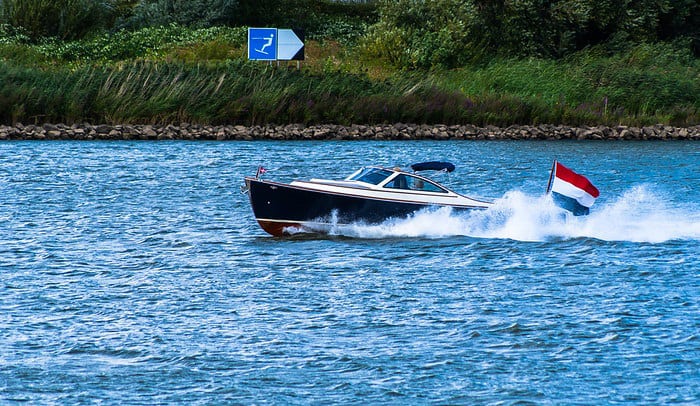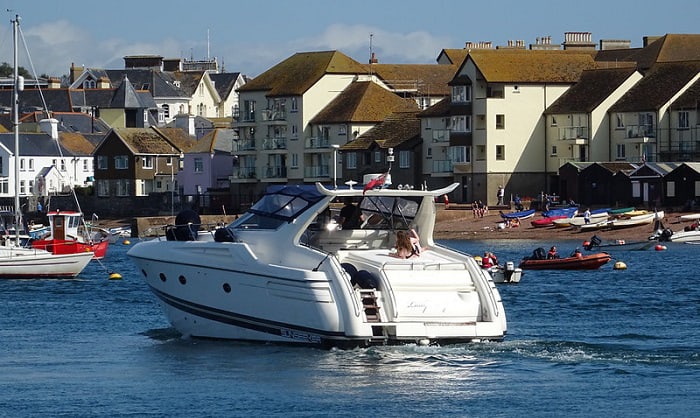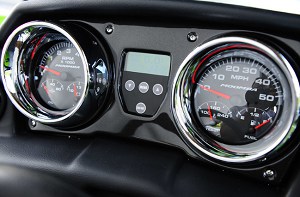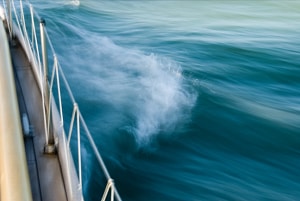As boaters, we face varying water conditions out at sea. When the waters get rough, you’ll have to be ready to make the necessary adjustments.
The same goes for the way our vessels undergo porpoising, regardless of whether the seas are calm or turbulent. These elements are the culprits for rough sailing, which isn’t really something anyone would want.
Once you learn how to trim your boat properly, you’ll be able to deal with them automatically and keep the ride butter-smooth. Correct boat tilt and trim also boost mileage and speed, so read on!
Table of Contents
Terms You Should Know Before We Begin
While you don’t really need anything else other than your boat to do these procedures, you must be aware of a few jargon terms so it won’t be hard for you to follow the steps I’ve outlined.
- Trimming Up or Out – means moving the propellers away from the transom so the motor pushes the stern down and raises the bow.
- Trimming Down or In – means moving the propellers toward the transom so the motor raises the stern and holds the bow down.
- Porpoising – the up and down movement of the boat’s bow caused by factors like uneven weight distribution and the position of the motor.
- Plane – when a boat is planing, coming up on plane, or is on plane, it means the boat has climbed over its bow wave, has minimal drag, and is smoothly skimming across the surface of the water.
6 Steps to Trim Your Boat with Power Trim
Is boat trim explained simply and completely? It’s possible as evidenced by the guide I’ve prepared here.
Step 1: Know When to Trim Your Boat Up or Down
To properly use trim on a boat, you need to be aware of when you should trim up or down.
- The best time to trim the boat up is when you’ve come up on plane. Keep in mind: most boats run optimally at a slightly raised bow angle because it reduces drag and improves overall efficiency.
- It’s recommended to trim the boat down if you’re currently in rough water and if the weather’s choppy in general. With the bow down, it will be able to part the waves more effectively.
Step 2: Trim the Motor Down
Obviously, we’re starting out stationary. We’ll need to trim our motor all the way down or in because you’ll normally need to keep the bow down in order to climb out of the bow wave.
To do this, you simply need to push the trim button or throttle down.
- Remember: In almost any power trim on a boat, the ‘Up’ button means bow down and the ‘Down’ button means bow up.
Step 3: Trim the Motor Up to Get Up on Plane
Once you get going, you should feel your boat beginning to climb out of the waves. Once you feel it’s starting to do so, you can trim the motor up.
You should feel the boat accelerating the second you start doing this. Essentially, you’re already up on plane at this point. A good sign of this is if the propeller shaft is parallel to the surface of the water.
Step 4: Watch Out for Porpoising
Inevitably, the boat will encounter some porpoising as it’s cruising, especially if you’ve trimmed the boat up too much. Once your boat’s bow starts performing that rhythmic bobbing up and down motion, you’ll need to adjust the motor’s position again.
Since it’s raised too much, you need to trim it down gradually. Push the ‘Down’ button until the motion settles out.
Once it does, chances are, you’ve achieved your ideal running angle. This shouldn’t be hard to do with power trim on a boat.
If the waves get too high, you may have to trim the motor down as low as possible. It may result in a dip in speed, but it will keep your ride smooth. Again, learn to adjust accordingly.
Step 5: Refer to Your Boat’s RPM Gauge
Look at your boat’s RPM gauge to know if you’ve achieved the ideal cruising speed. You should know that it’s running optimally if the RPM is at least 3,000 to 4,000 or 5,000 up to 5,800.
There’s a noticeable difference in best cruising speed because not all boats are the same. However, it’s safe to say that many sailors consider those numbers their sweet spot, and once you become more experienced, you’ll be able to know that’s the case by feeling alone.
Step 6: Familiarize Yourself with the Signs that You’ve Optimally Trimmed Your Boat
Take Note: Usually, achieving the most suitable trim is based on feel, sight, or sound. Every motor sounds different.
- In my case, I immediately know whether my Mercury motor is trimmed up or down based on the subtle changes in pitch it makes. If it’s down, the whining sound it makes becomes deeper, for example. Feel free to adopt this practice if you happen to have the same motor or if these sound cues can be applied to your motor.
- Another good way to know that your boat is adequately trimmed or on plane is if the waves on the port and starboard sides start to move further back. The changes in the shape of the waves are good references as well.
This is why the best tip I can give you when trimming an outboard motor is to familiarize yourself with your vessel.
How to Manually Trim Your Boat
Although there are rarely any modern boats without power trim nowadays, I’m not completely ruling out the possibility. If that’s the case, you’ll have to learn how to trim the outboard motor manually.
Moreover, I understand that some outboards are small enough not to include power trim, but may still need to be trimmed manually depending on the situation.
Besides, it’s worth learning this if your power trim happens to malfunction all of a sudden and you need to trim it.
Manual boat trim explained:
- Look for the pin on the motor bracket with a set number of holes. The best way to find out where it is is to refer to the manufacturer’s instructions for the motor.
- The hole you put the pin in will determine the angle of the bow. Since you are without a throttle system, you will only be able to perform this adjustment while the boat is idle.
- Decide the best hole to place the pin based on factors like added weight due to the passengers you’re carrying or the time it takes for you to plane.
Conclusion
What did you think of my boat engine trim tutorial? While I admit that every boat is different, the guide I presented here is universal since it considers all the fundamental factors involved.
Wind and water conditions may change, but now that you know how to trim your boat, you should be able to make adjustments easily. The important thing is to keep your ride free from those nausea-inducing oscillations as much as possible.

“My intention from the first day establishing Boating Basics Online is to provide as much help as possible for boaters who want to experience a first safe and convenient trip. So feel free to join us and share your beautiful journeys to the sea!”




